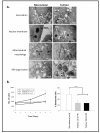An imbalance in progenitor cell populations reflects tumour progression in breast cancer primary culture models
- PMID: 21521500
- PMCID: PMC3094256
- DOI: 10.1186/1756-9966-30-45
An imbalance in progenitor cell populations reflects tumour progression in breast cancer primary culture models
Abstract
Background: Many factors influence breast cancer progression, including the ability of progenitor cells to sustain or increase net tumour cell numbers. Our aim was to define whether alterations in putative progenitor populations could predict clinicopathological factors of prognostic importance for cancer progression.
Methods: Primary cultures were established from human breast tumour and adjacent non-tumour tissue. Putative progenitor cell populations were isolated based on co-expression or concomitant absence of the epithelial and myoepithelial markers EPCAM and CALLA respectively.
Results: Significant reductions in cellular senescence were observed in tumour versus non-tumour cultures, accompanied by a stepwise increase in proliferation:senescence ratios. A novel correlation between tumour aggressiveness and an imbalance of putative progenitor subpopulations was also observed. Specifically, an increased double-negative (DN) to double-positive (DP) ratio distinguished aggressive tumours of high grade, estrogen receptor-negativity or HER2-positivity. The DN:DP ratio was also higher in malignant MDA-MB-231 cells relative to non-tumorigenic MCF-10A cells. Ultrastructural analysis of the DN subpopulation in an invasive tumour culture revealed enrichment in lipofuscin bodies, markers of ageing or senescent cells.
Conclusions: Our results suggest that an imbalance in tumour progenitor subpopulations imbalances the functional relationship between proliferation and senescence, creating a microenvironment favouring tumour progression.
Figures





References
-
- Molyneux G, Geyer FC, Magnay FA, McCarthy A, Kendrick H, Natrajan R, Mackay A, Grigoriadis A, Tutt A, Ashworth A, BRCA1 basal-like breast cancers originate from luminal epithelial progenitors and not from basal stem cells. Cell Stem Cell. pp. 403–417. - PubMed
-
- Ginestier C, Hur MH, Charafe-Jauffret E, Monville F, Dutcher J, Brown M, Jacquemier J, Viens P, Kleer CG, Liu S. et al.ALDH1 is a marker of normal and malignant human mammary stem cells and a predictor of poor clinical outcome. Cell Stem Cell. 2007;1:555–567. doi: 10.1016/j.stem.2007.08.014. - DOI - PMC - PubMed
Publication types
MeSH terms
Substances
LinkOut - more resources
Full Text Sources
Medical
Research Materials
Miscellaneous

